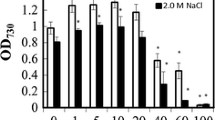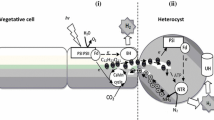Summary
Permeabilities of ammonia (NH3), methylamine (CH3NH2) and ethylamine (CH3CH2NH2) in the cyanobacterium (cyanophyte)Synechococcus R-2 (Anacystis nidulans) have been measured. Based on net uptake rates of DCMU (dichlorophenyldimethylurea) treated cells, the permeability of ammonia was 6.44±1.22 μm sec−1 (n=13). The permeabilities of methylamine and ethylamine, based on steady-state14C labeling were more than ten times that of ammonia (P methylamine=84.6±9.47 μm sec−1 (76),P ethylamine=109±11 μm sec−1 (55)). The apparent permeabilities based on net uptake rates of methylamine and ethylamine uptake were significantly lower, but this effect was partially reversible by ammonia, suggesting that net amine fluxes are rate limited by proton fluxes to an upper limit of about 700 nmol m−2 sec−1. Increasing concentrations of amines in alkaline conditions partially dissipated the pH gradient across the cell membrane, and this property could be used to calculate the relative permeabilities of different amines. The ratio of ethylamine to methylamine permeabilities was not significantly different from that calculated from the direct measurements of permeabilities; ammonia was much less effective in dissipating the pH gradient across the cell membrane than methylamine or ethylamine. An apparent permeability of ammonia of 5.7±0.9 μm sec−1 could be calculated from the permeability ratio of ammonia to methylamine and the experimentally measured permeability of methylamine. The permeability properties of ammonia and methylamine are very different; this poses problems in the interpretation of experiments where14C-methylamine is used as an ammonia analogue.
Similar content being viewed by others
References
Allen, M.M. 1968. Simple conditions for growth of unicellular blue-green algae.J. Phycol. 4:1–3
Atkins, G.L. 1969. Multicompartment Models in Biological Systems. Methuen, London
Barr, C.E., Koh, M.S., Ryan, T.E. 1974. NH3 efflux as a means for measuring H+ extrusion inNitella.In: Membrane Transport in Plants. U. Zimmermann and J. Dainty, editors. pp. 180–185. Springer-Verlag, New York-Heidlberg-Berlin
Beilby, M.J., Smith, F.A., Walker, N.A. 1980. The processes transporting CH3NH2 and CH3NH 3+ across theChara plasmalemma.In: Plant Membrane Transport: Current Conceptual Issues. R.M. Spanswick, W.J. Lucas, and J. Dainty, editors. pp. 601–602. Elsevier/North Holland Biomedical, Amsterdam
Boussiba, S., Dilling, W., Gibson, J. 1984a. Methylammonium transport inAnacystis nidulans R-2.J. Bacteriol. 160:204–210
Boussiba, S., Gibson, J. 1985. The role of glutamine synthetase activity in ammonium and methylammonium transport inAnacystis nidulans.FEBS Lett. 180:13–16
Boussiba, S., Resch, C.M., Gibson, J. 1984b. Ammonia uptake and retention in some cyanobacteria.Arch. Microbiol. 138:287–292
Bradford, M.M. 1976. A rapid and sensitive method for the quantitation of microgram quantities of protein utilizing the principle of dye-binding.Anal. Biochem. 72:248–254
Butler, T.C., Waddell, W.J., Poole, D.T. 1967. Intracellular pH based on the distribution of weak electrolytes.Fed. Proc. 26:1327–1332
Collander, R. 1954. The permeability ofNitella cells to nonelectrolytes.Physiol. Plant. 7:420–445
Crofts, A.R. 1966a. Uptake of ammonium ion by chloroplasts, and the mechanism of amine uncoupling.Biochem. Biophys. Res. Commun. 24:127–134
Crofts, A.R. 1966b. Uptake of ammonium by chloroplasts and its relation to photophosphorylation.Biochem. Biophys. Res. Commun. 24:725–731
Crofts, A.R. 1967. Amine uncoupling of energy transfer in chloroplasts.J. Biol. Chem. 242:3352–3359
Gaensslen, R.E., McCarty, R.E. 1971. Amine uptake in chloroplasts.Arch. Biochem. Biophys. 147:55–65
Gibson, J. 1981. Movement of acetate across the cytoplasmic membrane of the unicellular cyanobacteriaSynechococcus andAphanocapsa.Arch. Microbiol. 130:175–179
Gibson, J. 1984. Nutrient transport by anoxygenic and oxygenic photosynthetic bacteria.Annu. Rev. Microbiol. 38:135–59
Gordon, J.K., Moore, R.A. 1981. Ammonium and methylammonium transport by the nitrogen-fixing bacteriumAzotobacter vinelandii.J. Bacteriol. 148:435–442
Hackette, S.L., Skye, G.E., Burton, C.U., Segel, H.I. 1970. Characterisation of an ammonium transport system in filamentous fungi with methylammonium-14C as substrate.J. Biol. Chem. 245:4241–4250
Heldt, H.W., Werdan, K., Milovancev, M., Geller, G. 1973. Alkalization of the chloroplast stroma caused by light dependent proton flux into the thylacoid space.Biochim. Biophys. Acta 314:224–241
Hind, G., Whittingham, C.P. 1963. Reduction of ferricyanide by choloroplasts in the presence of nitrogenous bases.Biochim. Biophys. Acta 75:194–202
Hope, A.B., Walker, N.A. 1975. The Physiology of Giant Algal Cells. Cambridge University Press, Cambridge
Howitz, K.T., McCarty, R.E. 1985. Kinetic characteristics of the chloroplast envelope glycolate transporter.Biochemistry 24:2645–2652
Ihlenfeldt, M.J.A., Gibson, J. 1975. CO2 fixation and its regulation inAnacystis nidulans (Synechococcus).Arch Microbiol. 102:13–21
Kallas, T., Dahlquist, F.W. 1981. Phosphorous-31 nuclear magnetic resonance analysis of internal pH during photosynthesis in the cyanobacteriumSynechococcus.Biochemistry 20:5900–5907
Kleiner, D. 1981. The transport of NH3 and NH 4+ across biological membranes.Biochim. Biophys. Acta 639:41–52
Kleiner, D. 1985a. Energy expenditure for cyclic retention of NH3/NH 4+ during N2 fixation byKlebsiella pneumoniae.FEBS Lett. 187:237–239
Kleiner, D. 1985b. Bacterial ammonium transport.FEMS Microbiol. Rev. 32:87–100
Krulwich, T.A. 1986. Bioenergetics of alkalophilic bacteria.J. Membrane Biol. 89:113–125
Masamoto, K., Nishimura, M. 1978. Estimation of the internal pH in cells of blue-green algae in dark and under illumination.J. Biochem. 82:483–487
McCarty, R.E., Coleman, C.H. 1970. Effect of hydrocarbon chain length on the uncoupling of photophosphorylation by amines.Arch. Biochem. Biophys. 141:198–206
Meister, A. 1974. Glutamine synthetase of mammals.In: The Enzymes. Vol. 10 (3rd Ed.) pp. 699–754. P.D. Boyer, editor. Academic, New York-London
Mewes, H.-H.W., Rafael, J. 1981. The 2-(dimethylaminostyryl)-1-methylpyridinium cation as indicator of the mitochondrial membrane potential.FEBS Lett. 131:7–10
Miller, A.G., Turpin, D.H., Canvin, D.T. 1984. Na+ requirement for growth, photosynthesis, and pH regulation in the alkalotolerant cyanobacteriumSynechococcus leopoliensis.J. Bacteriol. 159:100–106
Mitchell, P. 1966. Chemiosmotic Coupling in Oxidative and Photosynthetic Phosphorylation. Glynn Research Laboratories, Bodmin, Cornwall, England
Mitchell, P., Moyle, J. 1969. Estimation of membrane potential and pH difference across the cristae of rat liver mitochondria.Eur. J. Biochem. 7:471–484
Nicholls, D.G. 1982. Bioenergetics: An Introduction to the Chemiosmotic Theory. Academic, London
Nobel, P.S. 1983. Introduction to Biophysical Plant Physiology, Freeman, San Francisco
O'Hara, G.W., Riley, I.T., Glenn, A.R., Dilworth, M.J. 1985. The ammonium permease ofRhizobium leguminosarum MNF 3841.J. Gen. Microbiol. 131:757–764
Padan, E., Zilberstein, D., Rottenberg, H. 1976. The proton electrochemical gradient inEscherichia coli cells.Eur. J. Biochem. 63:533–541
Raven, J.A., Farquhar, G.D. 1981. Methylammonium transport inPhaseolus vulgaris leaf slices.Plant Physiol. 67:859–863
Reed, R.H., Rowell, P., Stewart, W.D.P. 1980. Components of the proton electrochemical potential gradient inAnabaena varibilis.Biochem. Soc. Trans. 8:707–708
Reed, R.H., Rowell, P., Stewart, W.D.P. 1981a. Uptake of potassium and rubidium ions by the cyanobacteriumAnabaena variabilis.FEMS Microbiol. Lett. 11:233–236
Reed, R.H., Rowell, P., Stewart, W.D.P. 1981b. Characterisation of the transport of potassium ions in the cyanobacteriumAnabaena variabilis Kutz.Eur. J. Biochem. 116:323–330
Reid, R.J., Walker, N.A. 1983. Adenylate concentrations inChara: Variability, effects of inhibitors and the relationship to protoplasmic streaming.Aust. J. Plant Physiol. 10:373–383
Ritchie, R.J. 1985. Energetic considerations of ion transport inEnteromorpha intestinalis (L.) Link.New Phytol. 100:5–24
Ritchie, R.J. 1987. The permeability of ammonia, methylamine and ethylamine in the charophyte,Chara corallina (C. australis).J. Exp. Bot. (in press)
Segel, I.H. 1976. Biochemical Calculations. John Wiley & Sons, New York
Slayman, C.L. 1970. Movement of ions and electrogenesis in microrganisms.Am. Zool. 10:377–392
Smith, F.A., Raven, J.A. 1976. H+ transport and regulation of cell pH.In: Encyclopedia of Plant Physiology. (New Series) Vol. 2, part A: Cells, pp. 317–346. U. Luttge and M.G. Pitman, editors. Springer-Verlag, Berlin
Smith, F.A., Walker, N.A. 1978. Entry of methylammonium ions intoChara internodal cells.J. Exp. Bot. 29:107–120
Solorzano, L. 1969. Determination of ammonia in natural waters by the phenolhypochlorite method.Limnol. Oceanogr. 14:799–801
Spanswick, R.M. 1981. Electrogenic ion pumps.Annu. Rev. Plant Physiol. 32:267–289
Walker, N.A., Pitman, M.G. 1976. Measurements of fluxes across membranes.In: Encyclopedia of Plant Physiology. (New Series) Vol. 2, Part A: Cells. pp. 93–126. (U. Luttge and M.G. Pitman, editors) Springer-Verlag, Berlin
Walker, N.A., Smith, F.A., Beilby, M.J. 1979. Amine uniport at the plasmalemma of charophyte cells. II. Ratio of matter to charge transported and permeability of free base.J. Membrane Biol. 49:283–296
Walter, A., Gutknecht, J. 1986. Permeability of small nonelectrolytes through lipid bilayer membranes.J. Membrane Biol. 90:207–217
West, I.A. 1980. Energy coupling in secondary active transport.Biochim. Biophys. Acta 604:91–126
Zar, J.H. 1974. Biostatistical Analysis. Prentice-Hall, Englewood Cliffs, N.J.
Author information
Authors and Affiliations
Rights and permissions
About this article
Cite this article
Ritchie, R.J., Gibson, J. Permeability of ammonia, methylamine and ethylamine in the cyanobacterium,Synechococcus R-2 (Anacystis nidulans) PCC 7942. J. Membrain Biol. 95, 131–142 (1987). https://doi.org/10.1007/BF01869158
Received:
Revised:
Issue Date:
DOI: https://doi.org/10.1007/BF01869158




